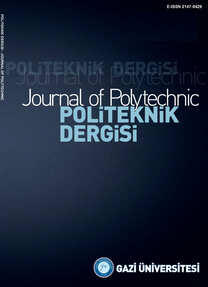Alternatif Gerilim Uygulanan Betonlarda S/Ç Oranının ve Hiperakışkanlaştırıcı Oranının Priz Bitiş Süresi ve Basınç Dayanımına Etkilerinin Araştırılması
Alternatif gerilim, beton, priz bitiş süresi
Investigation of the Impacts of W/C Ratio and Hyper Plasticizer Ratio on Final Setting Time and Compressive Strength for the Concretes to which Alternating Current Applied
Alternating voltage, concrete, final setting time,
___
- Referans1 Pavlenko S.I., “Heat treatment of fine- grained cementless concrete based on high-calcium fly ash and slag from thermal power plants”, Materials and Structures, 153: 657-674, (1994).
- Referans2 Tokyay M., “Strength prediction of fly ash concretes by accelerated testing”, Cement Concrete Research, 29: 1737-1741, (1999).
- Referans3 Wei X., Li Z., “Early hydration process of portland cement paste by electrical measurement”, J Mater Civ Eng, 18: (1) 99-105, (2006).
- Referans4 McCarter W.J., Chrisp T.M., Starrs G., Blewett J., “Characterization and monitoring of cement-based systems using intrinsic electrical property measurements”. Cement and Concrete Research, 33: 197-206, (2003).
- Referans5 Koleva D.A., Copuroglu O., Vanbreugel K., Ye G., Wit J.H.W., “Electrical resistivity and microstructural properties of concrete materials in conditions of current flow”. Cement and Concrete Composites. 30: 731-744, 14, (2007).
- Referans6 Ghoddousi P., Saadabadi L.A., “Study on hydration products by electrical resistivity for self- compacting concrete with silica fume and metakaolin”, Construction and Building Materials. 154: 219-228, (2017).
- Referans7 Schwarz N., Dubois M., Neithalath N., “Electrical conductivity based characterization of plain and coarse glass powder modified cement pastes”, Cement and Concrete Composites. 29: 656-666, (2007).
- Referans8 Uygunoğlu T., Hocaoğlu I., Topçu I.B., “Electrical Curing Application on Cement based Mortar with Different Stress Intensity”, ISBS 2017: Proceedings of 3rd International Sustainable Buildings Symposium (ISBS 2017), 462-468, (2017).
- Referans9 Liao Y., Wei X., Li G., “Early hydration of sulfoaluminate cement through electrical resistivity measurement and microstructure investigations”, Construction and Building Materials. 25: 1572-1579, (2011).
- Referans10 Yim H.J., Kim J.H., Shah S.P., “Ultrasonic monitoring of the setting of cement-based materials: Frequency dependence”, Construction and Building Research. 65: 518-525, (2014).
- Referans11 Koleva D.A., Copuroglu O., Breugel K.V., Ye G., Wit J.H.W. de., “Electrical resistivity and microstructural properties of concrete materials in conditions of current flow”, Cem Concr Comp, 30: 731-744, (2008).
- Referans12 Topçu İ.B., Uygunuğlu T., Hocaoğlu İ., “Electrical conductivity of setting cement paste with different mineral admixtures”, Construction and Building Materials, 28: 414-420, (2012).
- Referans13 Topçu İ.B., Uygunuğlu T., Hocaoğlu İ., “Electrical resistivity of fly ash blended cement paste at hardening state”, Materials Science 22: 458-462, (2016).
- Referans14 Rajabipour F., Weiss J., “Electrical conductivity of drying cement paste”, Mater Struc, 40: 1143-1160, (2007).
- Referans15 Uygunoğlu T., Hocaoğlu I., “Effect of electrical curing application on setting time of concrete with different stress intensity”, Construction and Building Materials. 162: 298-305, (2018).
- Referans16 Topçu İ. B., Uygunoğlu T. ve Hocaoğlu İ., “Yüksek fırın curuf katkılı çimento pastalarının elektriksel özdirençlerinin araştırılması”, Politeknik Dergisi, 21(2): 257-264, (2018).
- Referans17 Heikal M., Morsy M.S., Aiad I., “Effect of treatment temperature on the early hydration characteristics of superplasticized silica fume blended cement pastes”, Cem Concr Res, 35: 680- 687, (2005).
- Referans18 Luo Y., Gan Y., Xu J., Yan Y., Shi Y., “Effect of electric field intensity and frequency of AC electric field on the small-scale ethanol diffusion flame behaviors”, Appl. Therm. Eng. 115: 1330–1336, (2017).
- Referans19 ASTM International, ASTM C1074-14, “Estimating Concrete Strength by the Maturity Method”, West Conshohocken, PA, (2011).
- ISSN: 1302-0900
- Yayın Aralığı: 6
- Başlangıç: 1998
- Yayıncı: GAZİ ÜNİVERSİTESİ
Mustafa Yusuf DEMİRCİ, İsmail YABANOVA
Barış ÖZLÜ, Halil DEMİR, Mustafa TÜRKMEN
Correction: A Fuzzy MCDM Approach to Determine the Most Influential Logistic Factors
Mehmet Burak ŞENOL, Aylin ADEM, Metin DAĞDEVİREN
ERSİN BAHÇECİ, YUSUF ÖZÇATALBAŞ
Odunun Yüzey Pürüzlülüğünün ve Adezyon Direncinin Yapay Sinir Ağları ile Tahmini
Effects of Character Recognition with Shell Histogram Method Using Plate Characters
Rukiye UZUN ARSLAN, Sedat DİKİCİ, Mürsel Ozan İNCETAŞ
Sivas İli Şartlarında Yatay Toprak Kaynaklı Isı Pompasının Isıtma ve Soğutma İçin Performans Analizi
Ertan BUYRUK, Ferhat KILINÇ, Mustafa CANER
Doluluk Oranlarının PLA ve PET Malzemelerin Mekanik Özellikleri Üzerine Etkileri
Hatice EVLEN, Merve Ayfer ÖZDEMİR, Aydın ÇALIŞKAN
Combustion Properties of Impregnated and Heat-Treated Wood Material
